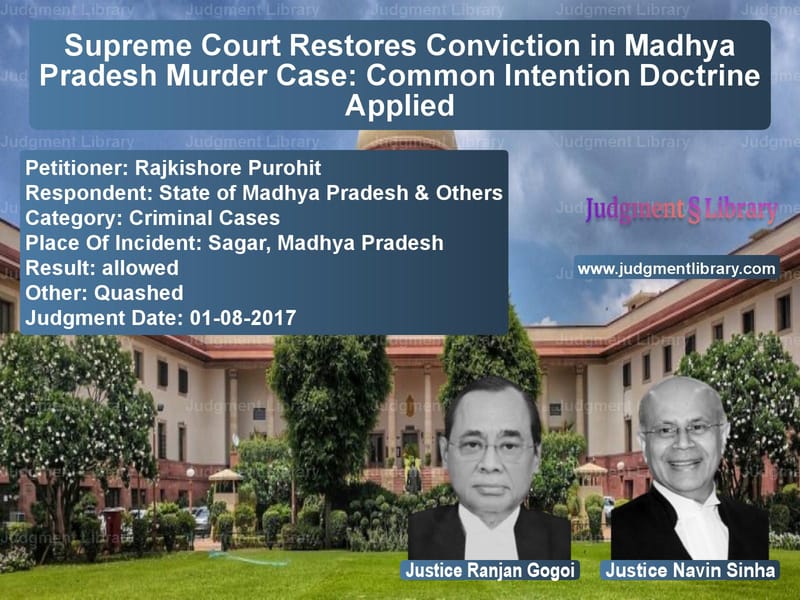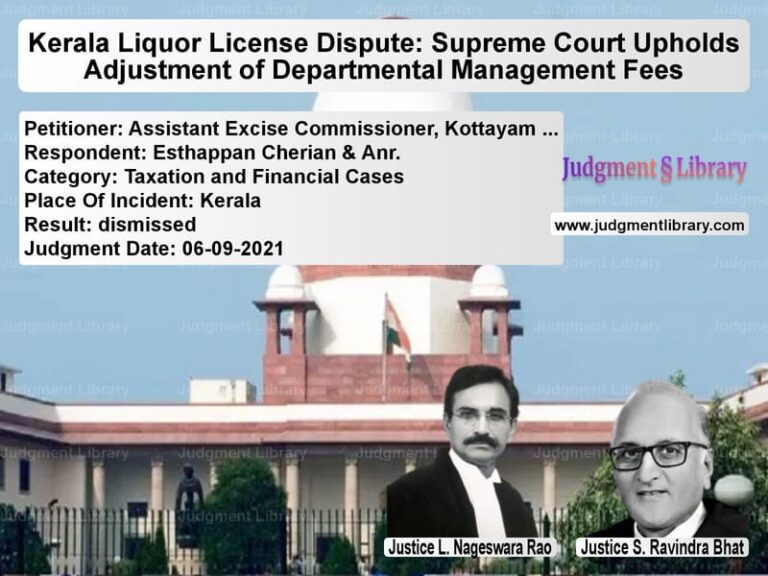Supreme Court Restores Conviction in Madhya Pradesh Murder Case: Common Intention Doctrine Applied
The case of Rajkishore Purohit vs. State of Madhya Pradesh & Others revolved around the murder of a political leader in Sagar, Madhya Pradesh. The Supreme Court was called upon to decide whether the acquittal of one of the accused was justified, considering the doctrine of common intention under Section 302/34 of the Indian Penal Code (IPC).
Background of the Case
The case involved the murder of the President of the Congress Sewa Dal, who was leading a campaign for the removal of the Mayor, Lokman Khatik (Accused No. 3), from office due to corruption allegations. The prosecution alleged that Khatik and three co-accused, including Respondent No. 2, conspired to kill the deceased. The trial court convicted all four accused, including Respondent No. 2, under Section 302/34 IPC and sentenced them to life imprisonment.
However, the Madhya Pradesh High Court, in appeal, acquitted Respondent No. 2 on the grounds that he had not actively participated in the crime, was not armed, and had not given any explicit exhortation to kill the deceased. The deceased’s brother, Rajkishore Purohit (the appellant), challenged the acquittal before the Supreme Court.
Arguments Presented
Appellant’s Arguments (Rajkishore Purohit)
The appellant contended that:
- The High Court erred in acquitting Respondent No. 2 despite clear evidence of common intention.
- Respondent No. 2 arrived at the scene along with the other accused in a white Ambassador car and moved toward the deceased.
- Eyewitnesses testified that Respondent No. 2 and another co-accused provided cover while Accused No. 2 shot the deceased.
- The trial court had correctly concluded that Respondent No. 2 shared the common intention to commit murder, even if he did not fire the weapon.
- The High Court’s ruling was based on conjecture rather than evidence, leading to a miscarriage of justice.
Respondent’s Arguments (State of Madhya Pradesh & Others)
The respondents countered that:
- Mere presence at the crime scene did not establish common intention.
- No overt act or exhortation was attributed to Respondent No. 2.
- The High Court rightly held that Respondent No. 2 might not have known that Accused No. 2 was carrying a revolver.
- The principle of common intention should not be applied mechanically.
Supreme Court’s Observations
The Supreme Court analyzed the doctrine of common intention under Section 34 IPC. The Court emphasized that:
“Common intention is a state of mind and is inferred from the conduct of the accused before, during, and after the occurrence.”
The Court cited precedents, including State of Rajasthan vs. Shobha Ram, which held that:
“Direct proof of common intention is seldom available; it must be inferred from the conduct of the accused and the surrounding circumstances.”
Examining the evidence, the Court found:
- Respondent No. 2 arrived at the scene with the other accused.
- He moved toward the deceased along with Accused No. 2 and another co-accused.
- Eyewitnesses testified that he provided cover while Accused No. 2 fired the fatal shot.
- After the shooting, all accused fled in the same vehicle.
The Court rejected the argument that Respondent No. 2 was unaware of the firearm, stating:
“The sequence of events and the conduct of the accused manifest a pre-concerted plan. It is irrelevant whether Respondent No. 2 held a weapon; his active participation demonstrates a shared intent to kill.”
Final Judgment
The Supreme Court allowed the appeal, set aside the High Court’s acquittal, and restored the trial court’s conviction of Respondent No. 2 under Section 302/34 IPC.
The Court directed Respondent No. 2 to surrender immediately to serve his remaining sentence, noting that:
- He had already served three years, ten months, and seven days.
- The order of life imprisonment was reinstated.
- There was no scope for leniency given the gravity of the offense.
The Supreme Court concluded:
“The High Court completely erred in its appreciation of evidence and application of legal principles. The acquittal is reversed, and Respondent No. 2 must surrender forthwith.”
Implications of the Judgment
This ruling has significant implications for criminal law and the doctrine of common intention:
- It clarifies that common intention can be inferred from circumstantial evidence, even in the absence of overt acts.
- It reinforces that accomplices who aid in the commission of a crime can be held equally responsible.
- It sets a precedent for appellate courts to exercise caution when overturning well-reasoned trial court judgments.
- The judgment ensures that criminal conspiracies are not overlooked due to procedural lapses.
Conclusion
The Supreme Court’s ruling in this case reaffirms the importance of the common intention doctrine in criminal law. By reinstating the conviction of Respondent No. 2, the Court ensured that justice was served, emphasizing that participation in a crime—whether direct or indirect—can establish liability under Section 34 IPC.
Don’t miss out on the full details! Download the complete judgment in PDF format below and gain valuable insights instantly!
Download Judgment: Rajkishore Purohit vs State of Madhya Prad Supreme Court of India Judgment Dated 01-08-2017.pdf
Direct Downlaod Judgment: Direct downlaod this Judgment
See all petitions in Murder Cases
See all petitions in Attempt to Murder Cases
See all petitions in Criminal Conspiracy
See all petitions in Judgment by Ranjan Gogoi
See all petitions in Judgment by Navin Sinha
See all petitions in allowed
See all petitions in Quashed
See all petitions in supreme court of India judgments August 2017
See all petitions in 2017 judgments
See all posts in Criminal Cases Category
See all allowed petitions in Criminal Cases Category
See all Dismissed petitions in Criminal Cases Category
See all partially allowed petitions in Criminal Cases Category







